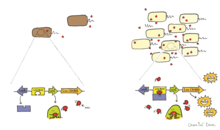Structural Biochemistry/Vibrio fischeri: Let there be light
Introduction
[edit | edit source]
Also known as Allivibrio fischeri, Vibrio fischeri are bioluminescent proteobacteriums in the marine environments. These gram-negatives bacterium's are rod-shaped, and most commonly found in symbiont relation with other marine animals (i.e. squids and fishes). But they may also exist as free-living. When free-living, bioluminescence may not occur since the bacteria are broadly spread in the water. As it will be discussed below, the density of the bacteria is a key factor in whether or not light will occur. When in a symbiont relation with other animals, there is an emission of light by the organism. This light is natural and involves release of energy. But the bacteria is not always lit. This depends on its density, which is regulated by the gene expression. These proteobacteriums are important in the study of bioluminescence, quorum sensing, and microbial symbiosis.
When choosing to colonize on an animal, it will do so on a day-to-day basis. This interaction cannot be done genetically. Scientifically, this would be referred to as 'acquiring horizontally'. The animal expels the bacteria in the day time, but they come and settle again in the nighttime. Because the Vibrio fischeri are abundant in the marine environment, they settle on animals that inhabit there. Those included are the Hawaiian Bobtail Squid and Anglerfish.
Quorum Sensing
[edit | edit source]Gram Negative
[edit | edit source]Quorum sensing is the chemistry involved in the bioluminescent bacterium's. It is the communication between cells that organize the expression of genes from the changes in the population density of the bacteria. In other words, it could be how the bacteria "speak" to each other through chemical signals to eventually light up in the waters. It is very dependent on the cell densities (high cell density vs. low cell density), and glows under certain conditions. When in low density (i.e. in the open marine sea) it, the luminescent genes are off. But if in high density (i.e. in symbiosis with the Hawaiian squid) the luminescent genes are on. Quorum sensing was first observed with the Vibrio fischeri. The chemistry when in relation with the Hawaiian Bobtail Squid will be explained:

The cells of the vibrio fischeri is a lux system containing various genes that regulate and organize the mioluminescence. Lux genes included are luxG, luxE, luxB, luxA, luxD, luxC, luxI, and luxR. The luxI gene synthesizes an autoinducer called the Acyl Homoserine Lactone (AHL). This is only produced in gram negative bacteria. Once produced, the autoinducer quickly diffuses out of the cell. This is where cell density comes into play- if there are a lot of exited inducers from many other cells, the crowded conditions will force the autoinducers back into the cell. It the cell density is low, the autoinducers are not likely to reenter the cells. Once entered back into cell, it binds to the luxR, which is a regulatory gene. the luxR-autoinducer complex activates transcription of the other genes to produce more luxI. This will enhance the production of more autoinducers. The process of autoinducers exiting and reentering the cell is greatly amplified. Ultimately, it is this process that is responsible for bioluminescence. More specifically, it is the luxA and luxB gene responsible for the light, as it produces a molecule, luciferase. The luciferase molecule catalyzes a redox reaction that eventually produces a blue-green light.
Gram Positive
[edit | edit source]Quorum Sensing may occur with gram positive bacteria as well. But the mechanism is a bit more complex. Instead of the AHL autoinducer that the gram negative bacteria produces, modified oligopeptides are produced, and are only secreted extracellular via specialized transporters. Other differences is that the lux-genes in the gram negative bacteria are cytoplasmis, while those in the gram positive are membrane bound.
The quorum sensing within gram positive bacteria can be organized into two systems: sensor kinase, and response regulator. With respective to the density of cells, the oligopeptide autoinducers are released extracellularly. The sensor kinase, that is embedded in the cell membrane, then bind to the signal if there is enough activity (high density). This leads to phosphorylation leading to the second system. The second system, the response regulator reacts to the phsphorylation and becomes active, allowing DNA transcription of the genes. The response regulator system is very sensitive to the environment and can act as repressors or activators.
Benefits of Symbiosis
[edit | edit source]
Both the Vibrio fischeri and the animal (i.e. Hawaiian Bobtail Squid) are able to benefit from the symbiosis relationship. The bacteria have a home and plenty of food. This is harmless to the squid (or other animals). The benefits for the animal is that they get camouflage from predators. During the nighttime, the moonlight shines down the waters. Without the bacteria, it would shine on the animal, and this would cause a shadow on the floor of the waters. Predators would then know that right above that shadow is a prey. So then when the Vibrio fischeri embed onto its friend, it emits a light that camouflage it as thought it were the moonlight. Win-win situation, and everyone is happy!
References
[edit | edit source]- http://www.wwnorton.com/college/biology/microbiology2/animations.aspx
- Trial, Rachelle, UCSD Bacteriology (BIMM 120) Lecture: "Quorem Sensing". Nov. 28, 2012